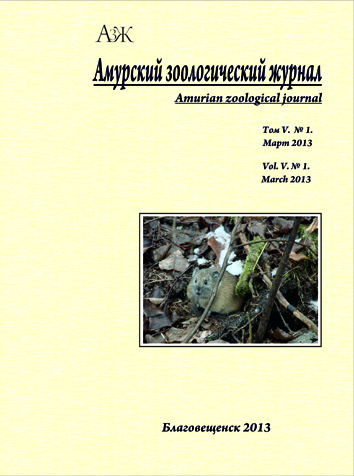NOTES ON THE FAUNA OF PRAYING MANTIDS (MANTODEA) OF THE KULUNDA STEPPE
DOI:
https://doi.org/10.33910/1999-4079-2013-5-1-16-20Keywords:
praying mantids, Mantodea, fauna, Kulunda plain, Altai Krai, Novosibirsk Oblast, Pavlodar ProvinceAbstract
2 species of the praying mantids (Mantodea) – Mantis religiosa (Linnaeus, 1758) and Iris polystictica (Fischer-Waldheim, 1846) are reported from the Kulunda steppe by the collections from Altai Krai of Russian Federation and Pavlodar Province of the Republic of Kazakhstan, supported by published data. Short review of morphology, ecology and distribution of these species is given.
References
Бей-Биенко Г.Я., 1964. Отряд Mantoptera – Богомоловые // Г.Я. Бей-Биенко (ред.): Определитель насекомых европейской части СССР. Т. 1. М.; Л. С. 170-173.
Большаков Л.В., Щербаков Е.О., Мазуров С.Г., Алексеев С.К., Рябов С.А., Ручин А.Б., 2010.
Самые северные находки богомола обыкновенного Mantis religiosa (Linnaeus, 1758) (Mantodea: Mantidae) в европейской России // Эверсманния. Вып. 23-24. С. 22-25.
Сергеев М.Г., 1985. Новые места нахождения прямокрылых (Orthoptera) в Сибири и их возможное зоогеографическое значение. Сообщение 2 // Г.С. Золотаренко (ред.): Членистоногие Сибири и Дальнего Востока. Новосибирск: Наука. С. 47-50.
Сергеев М.Г., 1990. Новые места нахождения прямокрылых (Orthoptera) в Сибири и их возможное зоогеографическое значение. Сообщение 3 // Г. С. Золотаренко (ред.): Редкие гельминты, клещи и насекомые. Новосибирск: Наука. С. 51-54.
Сергеев М.Г., 2000. Богомол испещренный – Iris polystictica (Fischer de Waldheim, 1846) // Красная книга Новосибирской области. Животные. Новосибирск: Госкомэкология.
Сергеев М.Г., Корчагина О.С., 2009. Опыт классификации плакорных сообществ прямокрылых насекомых (Orthoptera) Кулундинской степи // Вестник Новосибирского государственного университета. Т. 7, вып. 4. С. 81-85.
Столяров М.В., 2009. Новый для фауны России богомол (Mantidae) // Энтомологическое обозрение. Т. 88, №1, С. 116-117.
Стороженко С.Ю., 1981. К фауне богомолов (Mantoptera) Дальнего Востока // Новые сведения о насекомых Дальнего Востока. Владивосток: Дальневосточный научный центр АН СССР. С. 3-5.
Bazyluk W., 1960. Die geographische Verbreitung und Variabilität von Mantis religiosa (L.) (Mantodea, Mantidae) sowie Beschreibungen neuer Unterarten. // Ann. Zoologici. T. 18, № 15. S. 231-272.
Berg M., Schwarz C.J., Mehl J.E., 2011. Die Gottesanbeterin. Mantis religiosa. Hohenwarsleben: Westarp Wissenschaften. 521 s.
Bey-Bienko G.Ya., 1929. Beiträge zur Kenntnis der Verbreitung der Orthopteren im Asiatischen Russland // Zoologischer Anzeiger. Bd. 81 (1/4). S. 67-72.
Ehrmann R., 2011. Mantodea from Turkey and Cyprus (Dictyoptera: Mantodea) // Articulata. Vol. 26 (1). P. 1-42.
Kaltenbach A.P., 1963. Kritische Untersuchungen zur Systematik, Biologie und Verbreitung der europäischen Fangheuschrecken (Dictyoptera-Mantidea) // Zoologische Jahrbücher. Syst. Bd. 90. S. 521-598.
Liana A., 2007. Distribution of Mantis religiosa (L.) and its changes in Poland // Fragmenta Faunistica. № 50 (2). P. 91-125.
Sjöstedt, Y., 1933. Schwedisch-chinesische wissenschaftliche Expedition nach den nordwestlichen Provinzen Chinas // Arkiv för Zoologi. Bd. 25A (4). S. 1-4.
Storozhenko S.Yu., Pushkar T. I., 2012. Notes on Orthoptera and Mantodea erroneously recorded from Altaiskii Krai, Russia // Far Eastern Entomologist. № 246. P. 12.
Wnukowsky, W., 1926. Über die Fauna der Dermaptera, Dictyoptera und Ensifera Sibiriens // Deutscher Entomologische Zeitschrift. № 5. S. 441-443.
Published
Issue
Section
License
Copyright (c) 2013 E. O. Shcherbakov, R. V. Yakovlev, S. V. Titov

This work is licensed under a Creative Commons Attribution-NonCommercial 4.0 International License.
The work is provided under the terms of the Public Offer and of Creative Commons public license Creative Commons Attribution 4.0 International (CC BY 4.0).
This license permits an unlimited number of users to copy and redistribute the material in any medium or format, and to remix, transform, and build upon the material for any purpose, including commercial use.
This license retains copyright for the authors but allows others to freely distribute, use, and adapt the work, on the mandatory condition that appropriate credit is given. Users must provide a correct link to the original publication in our journal, cite the authors' names, and indicate if any changes were made.
Copyright remains with the authors. The CC BY 4.0 license does not transfer rights to third parties but rather grants users prior permission for use, provided the attribution condition is met. Any use of the work will be governed by the terms of this license.







